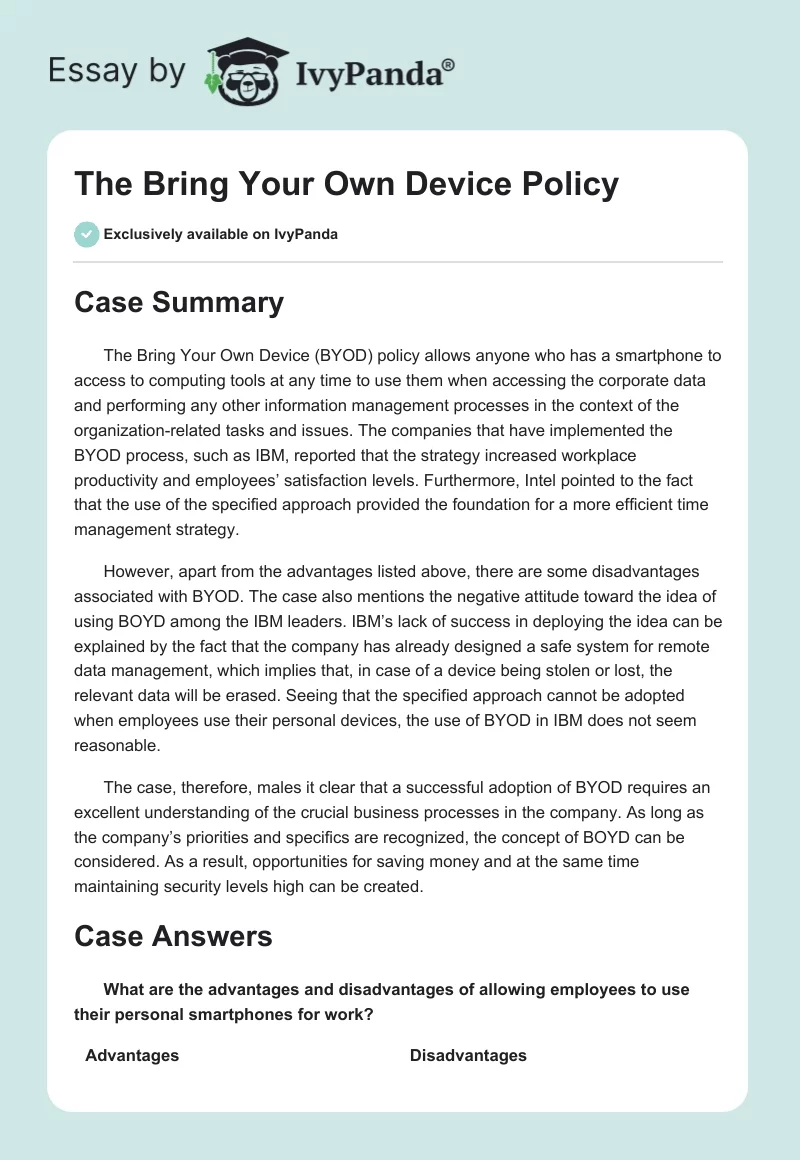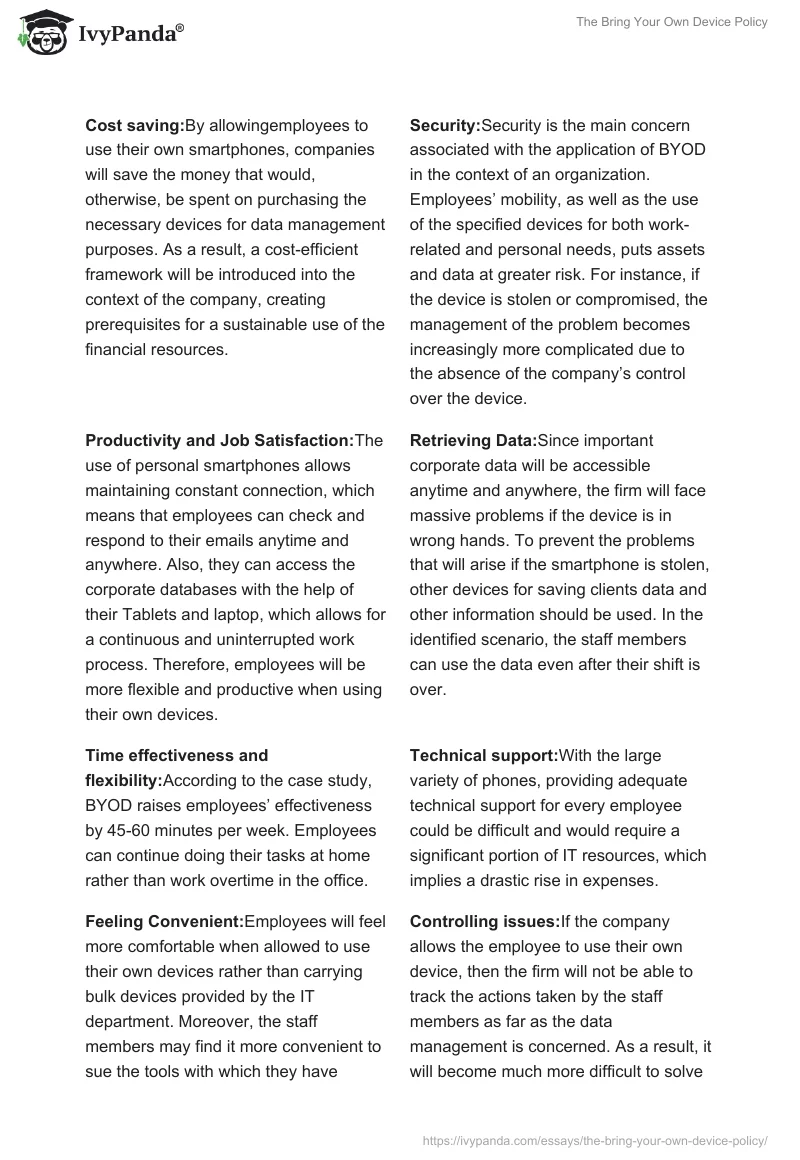Case Summary
The Bring Your Own Device (BYOD) policy allows anyone who has a smartphone to access to computing tools at any time to use them when accessing the corporate data and performing any other information management processes in the context of the organization-related tasks and issues. The companies that have implemented the BYOD process, such as IBM, reported that the strategy increased workplace productivity and employees’ satisfaction levels. Furthermore, Intel pointed to the fact that the use of the specified approach provided the foundation for a more efficient time management strategy.
However, apart from the advantages listed above, there are some disadvantages associated with BYOD. The case also mentions the negative attitude toward the idea of using BOYD among the IBM leaders. IBM’s lack of success in deploying the idea can be explained by the fact that the company has already designed a safe system for remote data management, which implies that, in case of a device being stolen or lost, the relevant data will be erased. Seeing that the specified approach cannot be adopted when employees use their personal devices, the use of BYOD in IBM does not seem reasonable.
The case, therefore, males it clear that a successful adoption of BYOD requires an excellent understanding of the crucial business processes in the company. As long as the company’s priorities and specifics are recognized, the concept of BOYD can be considered. As a result, opportunities for saving money and at the same time maintaining security levels high can be created.
Case Answers
What are the advantages and disadvantages of allowing employees to use their personal smartphones for work?
What management, organization, and technology factors should be addressed when deciding whether to allow employees to use their personal smartphones for work?
Compare the BYOD experiences of IBM and Intel. Why did BYOD at Intel work so well?
Why did BYOD at Intel work so well?
- Intel developed different policies, rules and access limits for each type of devices and provided a list of approved devices.
- Intel’s goal was creating a favorable environment for employees and helping them work productivity but not saving money.
- Employees liked being able to use their own devices and apps along with specialized Intel apps.
Allowing employees use their own smartphones for work will save the company money. Do you agree? Why or why not?
The decision to allow employees to use their own smartphones anytime anywhere has more advantages than disadvantages from our point of view. The advantages are listed below:
Reducing monthly costs of company’s telecommunication processes.
When employees use their own smartphones, it gives them the flexibility and enhances their productivity since they are familiar with the devices that they use and, therefore, are bound to work faster and more efficiently. For instance, they know how to use the device efficiently to avoid lagging, access the folders with the relevant data, carry out the search process, communicate with others, etc. When being handed a corporate device, employees will have to spend a significant amount of time getting used to it. In addition, the company will not have to be concerned about taking expenses to purchase the necessary devices. Instead, the organization will focus on reimbursement for the monthly data plan. Therefore, the current approach used to manage the staff’s needs can be redesigned toward a more employee-focused one, with the following increase in staff satisfaction rates. Consequently, the loyalty levels among employees will rise.
Improving the financial resources management strategy by not having to purchase smartphones.
Since employees will use their own smartphones for work-related communication, purchasing the devices for the staff’s needs will no longer be required. As a result, a significant amount of money will be saved. Consequently, the money can be used to augment the funds for other company-related processes. The financial resources in question can, later on, be used to focus on other areas of the firm’s operation, such as the R&D-associated ones. Thus, the development of a competitive advantage can become a possibility. Alternatively, the money can be used to support the development of the company’s supply chain and the enhancement of the logistics processes. In other words, the company will save cost while maintaining the employees’ performance at the required high level.
Improving the corporate financial strategy by removing the expenses associated with the upgrade of smartphones.
Unless regularly upgraded, the platforms used by employees may create a communication barrier between them and their customers. Sometimes the customer uses a certain platform, which may not be compatible with the employee’s device. However, most of the platforms offer free upgrades and have special Apps to cope with the changes in the identified area. It is likely that the staff members are enthusiastic about updating their smartphones and using the latest communication tools. Therefore, the company promoting the use of BYOD will experience a significant improvement in the quality of customer-employee communication.
Reducing the costs for the use of technical support services.
Most employees know how to manage their own smart devices since they are familiar with the technology. Moreover, free open source operating systems such as Android are self-taught and provided with opportunities for regular upgrades. Consequently, the company will not spend a lot of time and money to resolve technical issues related to the use of smartphones and similar devices. Granted that not all staff members are technologically advanced and may need help in acquiring the relevant skills, they are likely to be more active in exploring it since they will not be afraid of having to pay for the device in case they break it. Thus, while admittedly having its problems, BYOD can be viewed as a rather efficient tool for corporate data management.


